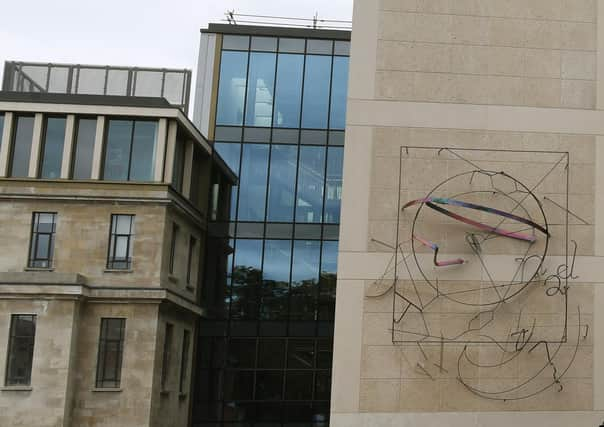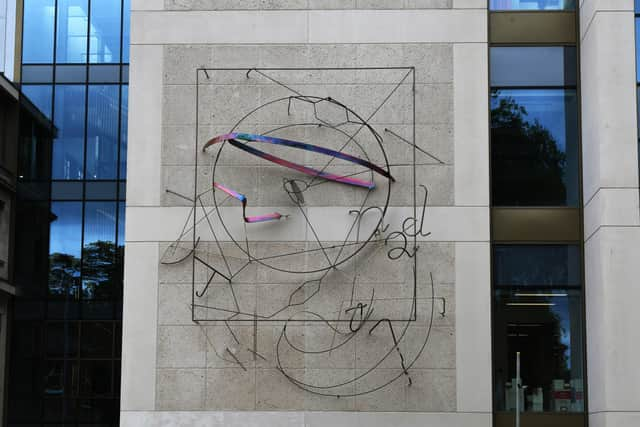Bragging rights: Leeds University unveils tribute to ‘father’ of DNA


Some thought the ideas propagated by William Henry Bragg were up the wall. As of today, they really are – sculpted on to the side of a new science development at his alma mater.
It was Bragg – to this day the only scholar to have shared a Nobel prize with his son – whose realisation that X-rays could be used for purposes other than examining broken bones paved the way for the discovery of DNA.
Advertisement
Hide AdAdvertisement
Hide AdHe was already a scientist of renown when he was brought to Leeds from Adelaide University in Australia to continue his work – but some at the university appeared to have been sceptical that it would amount to much.


“If he thought he was going to be given state of the art facilities he was in for a shock,” said Dr Kersten Hall, a visiting fellow and science historian. “When he got here they put him up in what was what was little more than a temporary shed. He wrote that he and his son Lawrence had to sit there in the freezing cold.”
The sculpture which was unofficially unveiled yesterday on the engineering and physical sciences facility on Woodhouse Lane, to be known as the Sir William Henry Bragg Building, went some way to making amends.
Commissioned from the artist Sara Barker, the three-dimensional installation in welded aluminium is called The Worlds of If and incorporates the equation behind what is now known as Bragg’s Law. It unfolds as viewers walk around the building.
Advertisement
Hide AdAdvertisement
Hide AdMs Barker said her aim had been to produce “a curve ball that might activate or completely transform the work in different lighting”.
Dr Hall said it was about time the university and the city began shouting about its involvement with one of the pivotal discoveries of 20th century science – one that laid the foundations for 28 more Nobel prize-winning researchers.
The principal previous acknowledgment was a blue plaque outside the Parkinson Building on the centre of the campus, where Sir William Bragg was eventually professor of physics. It commemorates his development of the first X-ray spectrometer and his pioneering work on the analysis of crystal structures using X-rays.
“X-ray crystallography is just a gift that keeps giving,” said Dr Hall, who has written a book called Dark Satanic Mills to DNA.
Advertisement
Hide AdAdvertisement
Hide Ad“It was absolutely crucial to the discovery that DNA has the double helix shape which explains how it passes on genetic information from one generation to the next. It was this method the Braggs developed from which we learned the shape of the insulin molecule, helped to solve the structure of penicillin and may yet be able to work out the shape of the spiked protein on the surface of the coronavirus.
“It’s an inspiring story for Leeds, and I wish it banged the drum about it more than it does.
“I hope that as people walk down Woodhouse Lane and glance up and see this sculpture, they take inspiration from it.”
Sir Alan Langlands, the university’s vice-chancellor said the new building would house laboratories and teaching spaces and that its signature sculpture was “a vibrant reminder of the power of science in shaping modern society”.
Support The Yorkshire Post and become a subscriber today.
Advertisement
Hide AdAdvertisement
Hide AdYour subscription will help us to continue to bring quality news to the people of Yorkshire. In return, you’ll see fewer ads on site, get free access to our app and receive exclusive members-only offers.
So, please – if you can – pay for our work. Just £5 per month is the starting point. If you think that which we are trying to achieve is worth more, you can pay us what you think we are worth. By doing so, you will be investing in something that is becoming increasingly rare. Independent journalism that cares less about right and left and more about right and wrong. Journalism you can trust.
Thank you
James Mitchinson
Comment Guidelines
National World encourages reader discussion on our stories. User feedback, insights and back-and-forth exchanges add a rich layer of context to reporting. Please review our Community Guidelines before commenting.